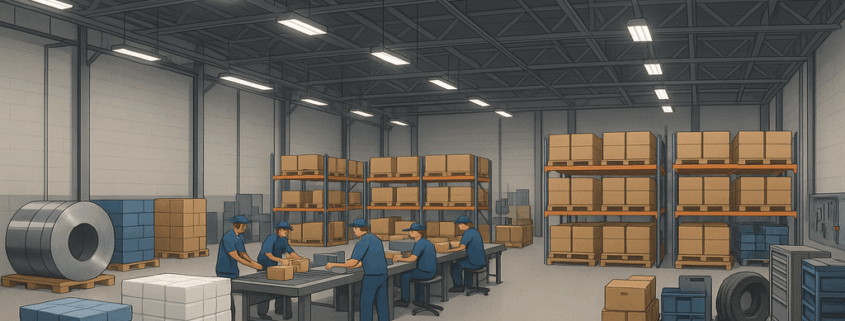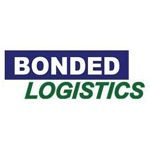4 Inventory Types Every Manager Should Know (and Why They Matter)
Raw Materials: The Foundation of Production
Raw materials represent the fundamental components that enter a warehouse before being transformed into finished products. These items can range from commodities like metals, plastics, and textiles to specialized components such as electronic parts, chemicals, or agricultural products. For manufacturers, these materials constitute the building blocks of their production processes and represent a significant portion of their inventory investment. The quality, availability, and cost of raw materials directly impact production capabilities, making their proper management a critical aspect of warehouse operations. In manufacturing environments, raw materials typically account for 30-40% of total inventory value, highlighting their significance in the overall supply chain ecosystem.

Managing raw materials effectively requires a multifaceted approach that balances supply availability with production demands. Proper management ensures production continuity while minimizing carrying costs associated with excessive inventory. Stockouts of critical raw materials can halt production lines, creating costly delays and potentially damaging customer relationships. Conversely, overstocking ties up capital and creates storage challenges while increasing the risk of obsolescence or deterioration. Warehouse managers must work closely with procurement and production departments to establish optimal inventory levels that satisfy production requirements without unnecessary excess. This delicate balancing act becomes particularly important in industries with volatile raw material prices or those dealing with perishable or hazardous materials.
Best practices for raw material management begin with implementing appropriate storage systems tailored to specific material requirements. Temperature-sensitive materials might require climate-controlled environments, while hazardous substances need specialized containment systems and compliance with safety regulations. Effective warehouse layouts should position frequently used raw materials in easily accessible locations to minimize handling time and transportation within the facility. Proper labeling and organization systems ensure materials can be quickly identified and retrieved when needed for production. These physical considerations form the foundation of efficient raw material management but must be paired with robust tracking systems to maintain inventory accuracy.
Digital inventory management systems have revolutionized raw material tracking capabilities, offering real-time visibility and enhanced control. Modern warehouse management systems (WMS) can track material quantities, locations, expiration dates, and quality specifications with precision. Implementing barcode scanning or RFID technology significantly reduces human error in inventory counts while accelerating receiving and picking processes. These systems can also facilitate batch tracking and lot control, which are essential for industries with traceability requirements or quality control concerns. Integration between inventory systems and production planning software enables automated reordering based on usage patterns and production forecasts, ensuring optimal raw material availability without excessive stock levels.
Work-in-Progress (WIP) inventory encompasses all materials that have entered the production process but have not yet emerged as finished goods. These partially completed products represent a transitional state where value is continuously being added through labor, machinery operations, and additional materials. WIP inventory appears in various forms depending on the manufacturing process – from partially assembled electronic devices to chemical compounds undergoing processing or furniture items awaiting finishing touches. The value of WIP inventory includes not only the cost of raw materials but also the accumulated labor, overhead, and machine time invested up to that point in production. This incremental value addition makes WIP inventory particularly important from both operational and accounting perspectives.

Managing WIP inventory presents unique challenges compared to other inventory types. Unlike raw materials or finished goods, WIP inventory is constantly in flux, moving through different production stages at varying speeds. This dynamic nature makes tracking and valuation more complex, requiring sophisticated systems to monitor progress and value accumulation. Production bottlenecks can cause WIP inventory to accumulate at specific points in the manufacturing process, creating physical congestion and financial inefficiencies. The visibility of WIP inventory is often limited, as items may be distributed across multiple workstations or production areas rather than centralized in a single warehouse location. Additionally, the variable completion status of WIP items complicates inventory counts and financial reporting, requiring standardized methods to assess completion percentages and associated values.
Excessive WIP inventory ties up valuable working capital and physical space while potentially masking production inefficiencies. Studies show that reducing WIP inventory by 30% can improve manufacturing cycle times by 15-20% and decrease operating costs by 5-10%. However, insufficient WIP inventory can create production delays and reduce equipment utilization rates. Finding the optimal balance requires understanding production flow rates, identifying potential bottlenecks, and implementing systems that provide real-time visibility into work-in-progress items. Cross-functional collaboration between production, warehouse, and finance departments is essential for effective WIP management, as each has different perspectives and requirements regarding this inventory category.
Strategies for streamlining WIP inventory often begin with implementing lean manufacturing principles that minimize excessive buffer stocks between production stages. Just-in-Time (JIT) production approaches can significantly reduce WIP inventory by scheduling production to match demand more precisely. Manufacturing execution systems (MES) provide digital tracking of items throughout the production process, enabling managers to identify bottlenecks and optimize workflow. These systems can be integrated with warehouse management software to provide a comprehensive view of inventory movement from raw materials through production to finished goods. Visual management techniques such as Kanban systems offer simple yet effective methods for controlling WIP inventory flow through production environments, using physical or digital cards to authorize production and movement of materials only when needed by downstream processes.
Finished Goods: Ready for Distribution
Finished goods represent the culmination of the production process – completed products ready for sale to customers or distribution to retail locations. These items have undergone all manufacturing processes, quality checks, and packaging requirements, representing the highest value inventory category in most warehouse operations. Finished goods inventory serves as the direct link between production capabilities and customer demand fulfillment, making its management particularly crucial for customer satisfaction and revenue generation. For manufacturing businesses, finished goods typically constitute 40-50% of total inventory value, while for distribution and retail operations, they may represent up to 80-90% of inventory investment. The management of this inventory category directly impacts a company’s ability to meet delivery commitments, maintain appropriate service levels, and optimize working capital utilization.
The effective management of finished goods inventory significantly influences both customer satisfaction and business profitability. Maintaining adequate stock levels ensures immediate availability when customer orders arrive, supporting faster fulfillment times and higher service levels. Research indicates that companies with optimal finished goods inventory management achieve 15-25% higher customer satisfaction rates and 5-10% higher profit margins compared to industry peers. However, excessive finished goods inventory creates substantial carrying costs – typically 20-30% of inventory value annually – including storage, insurance, depreciation, and opportunity cost of capital. Obsolescence risk is particularly high for finished goods, especially in industries with rapid product cycles or seasonal demand patterns. Balancing these competing factors requires sophisticated demand forecasting capabilities, strategic inventory positioning, and efficient order fulfillment processes.

Storage and organization of finished goods require careful planning to maximize space utilization while ensuring easy access for order picking. Warehouse layouts should position high-velocity items in easily accessible locations to minimize travel time during picking operations. Vertical space utilization through appropriate racking systems can dramatically increase storage capacity while maintaining orderly organization. Many warehouses implement zoning strategies that group similar products together or organize items based on picking frequency. Advanced warehouses utilize slotting optimization software to determine optimal product placement based on multiple factors including size, weight, velocity, and complementary items frequently ordered together. Proper labeling systems and location identification are essential for maintaining inventory accuracy and enabling efficient retrieval operations.
Technology plays an increasingly important role in finished goods management, with automated systems enhancing both accuracy and efficiency. Automated storage and retrieval systems (AS/RS) can maximize space utilization while accelerating picking operations. Voice-directed and light-directed picking technologies reduce error rates while increasing productivity. Warehouse management systems provide real-time inventory visibility, enabling proactive management of stock levels and strategic allocation decisions. For businesses with multiple distribution centers, distributed order management systems optimize order routing to balance service levels with fulfillment costs. The integration of these technologies with transportation management systems further streamlines the entire order-to-delivery process, ensuring that finished goods move efficiently from warehouse shelves to customer locations. As e-commerce continues to grow, the ability to manage finished goods inventory across multiple channels becomes increasingly important for meeting diverse customer expectations.
Maintenance, Repair, and Operations (MRO) Supplies
Maintenance, Repair, and Operations (MRO) supplies encompass the wide array of items that support warehouse and production operations without becoming part of the final product. These supplies include maintenance tools, spare parts for equipment, cleaning supplies, safety equipment, office supplies, and consumables used throughout facility operations. While MRO items typically represent only 5-10% of a company’s inventory value, they often account for 80% of inventory SKUs and up to 50% of total purchase transactions, creating significant administrative complexity. The diverse nature of MRO supplies – ranging from inexpensive consumables like lubricants and cleaning solutions to costly replacement parts for critical machinery – necessitates tailored management approaches. Despite their relatively lower value compared to product-related inventory, effective MRO management is essential for maintaining operational continuity and preventing costly downtime.
The impact of MRO supplies on operational efficiency extends far beyond their direct cost. Inadequate MRO inventory can lead to equipment downtime, with studies showing that unplanned downtime costs industrial manufacturers an estimated $50 billion annually. A single hour of unexpected production stoppage can cost between $10,000 and $250,000 depending on the industry and operation scale. Conversely, excessive MRO inventory ties up capital and warehouse space while creating additional management complexity. Many organizations struggle with MRO management due to irregular consumption patterns, long lead times for specialized parts, and the critical nature of certain components. Proper MRO inventory management requires balancing the risk and cost of stockouts against the carrying costs of maintaining adequate safety stock, particularly for critical equipment components where substitutions may not be possible.
Effective MRO inventory management begins with proper categorization and prioritization based on criticality, usage patterns, and procurement characteristics. Critical spare parts that could cause significant operational disruptions require different stocking strategies compared to routine consumables. ABC analysis can help identify which items demand the most rigorous management controls based on value and criticality. Standardizing MRO items across facilities whenever possible reduces inventory requirements while simplifying procurement processes. Establishing clear ownership and accountability for MRO inventory management prevents the common problem of departmental hoarding and duplicate purchasing. Many organizations benefit from vendor-managed inventory (VMI) programs for MRO supplies, where suppliers maintain responsibility for monitoring usage and replenishing stock based on predetermined parameters, reducing administrative burden while ensuring availability.
Technology solutions have transformed MRO inventory management capabilities, offering improved visibility and control. Computerized maintenance management systems (CMMS) integrate equipment maintenance schedules with parts inventory, ensuring critical components are available when needed for planned maintenance. Mobile scanning technologies simplify inventory transactions by allowing maintenance technicians to check out parts directly at the point of use. Automated dispensing systems for high-usage consumables provide controlled access while automatically triggering replenishment orders. For critical but infrequently used parts, pooling arrangements between facilities or even companies in the same industry can reduce overall inventory investment while maintaining access when needed. Advanced analytics can identify consumption patterns and optimization opportunities, enabling more precise forecasting and stocking decisions that balance availability with inventory investment.
Conclusion
Understanding and effectively managing the four primary types of warehouse inventory – raw materials, work-in-progress, finished goods, and MRO supplies – is essential for optimizing warehouse operations and financial performance. Each inventory category presents unique challenges and requirements, necessitating tailored strategies for storage, tracking, and replenishment. Raw materials management focuses on ensuring production continuity without excessive stockpiling, while WIP inventory requires visibility throughout the production process to prevent bottlenecks and excess accumulation. Finished goods management directly impacts customer satisfaction and revenue generation, demanding sophisticated approaches to forecasting, storage, and distribution. MRO supplies, though often overlooked, play a critical role in maintaining operational continuity and preventing costly downtime.
The interconnected nature of these inventory types underscores the importance of an integrated approach to warehouse management. Modern warehouse management systems that provide visibility across all inventory categories enable better decision-making and resource allocation. By implementing category-specific best practices while maintaining a holistic view of inventory operations, warehouse managers can significantly enhance operational efficiency, reduce costs, and improve service levels. As supply chains continue to evolve with increasing complexity and customer expectations, mastering these fundamental inventory types provides the foundation for warehouse excellence and competitive advantage in the marketplace.
Frequently Asked Questions (FAQ)
Q1: Why is it important for warehouse managers to differentiate between types of inventory?
Differentiating between types of inventory allows warehouse managers to apply specific strategies tailored to each category, enhancing overall efficiency and reducing costs. For instance, raw materials require different storage conditions compared to finished goods, and mismanagement can lead to production delays or excess inventory holding costs. Understanding each inventory type also aids in accurate inventory valuation and effective use of inventory methods, which are crucial for financial reporting and decision-making. This strategic approach ensures that resources are utilized optimally, leading to improved operational performance and profitability.
Q2: How do inventory types affect warehouse layout and design?
Different inventory types have unique storage requirements that significantly impact warehouse layout and design. Raw materials often need bulk storage areas with reinforced flooring for heavy materials, while hazardous materials require specialized containment systems. WIP inventory benefits from flexible storage near production areas, often with temporary staging locations. Finished goods typically require organized picking areas with consideration for order frequency and size. MRO supplies are best centralized in secure areas with controlled access. A well-designed warehouse considers the flow between these inventory types, minimizing unnecessary movement while maximizing storage efficiency and accessibility. Modern warehouse designs incorporate zone-based layouts that separate inventory types while facilitating smooth transitions between areas.
Q3: What inventory valuation methods work best for different inventory types?
The optimal inventory valuation method varies by inventory type and business context. For raw materials, particularly commodities subject to price fluctuations, FIFO (First-In-First-Out) often provides the most accurate valuation by reflecting current market conditions. WIP inventory typically requires job costing or process costing methods that accurately capture accumulated labor and overhead in addition to material costs. Finished goods are commonly valued using standard costing methods for manufacturing operations or weighted average cost methods for distribution businesses. MRO supplies, due to their support nature, are often expensed immediately or valued using simplified methods like LIFO (Last-In-First-Out) where permitted. The choice of valuation method should align with industry standards, financial reporting requirements, and management decision-making needs.
Q4: How can technology improve management of different inventory types?
Technology solutions offer targeted benefits for each inventory type. For raw materials, supplier integration and advanced forecasting tools optimize procurement timing and quantities. WIP inventory benefits from manufacturing execution systems (MES) that provide real-time visibility into production status and location. Finished goods management is enhanced through warehouse management systems with advanced picking algorithms and inventory optimization capabilities. MRO supplies can be managed through computerized maintenance management systems (CMMS) integrated with inventory controls. Across all categories, RFID and barcode systems improve tracking accuracy, while IoT sensors enable condition monitoring for sensitive items. Cloud-based inventory platforms provide comprehensive visibility across locations, while artificial intelligence and machine learning technologies increasingly drive predictive analytics for demand forecasting and inventory optimization.










